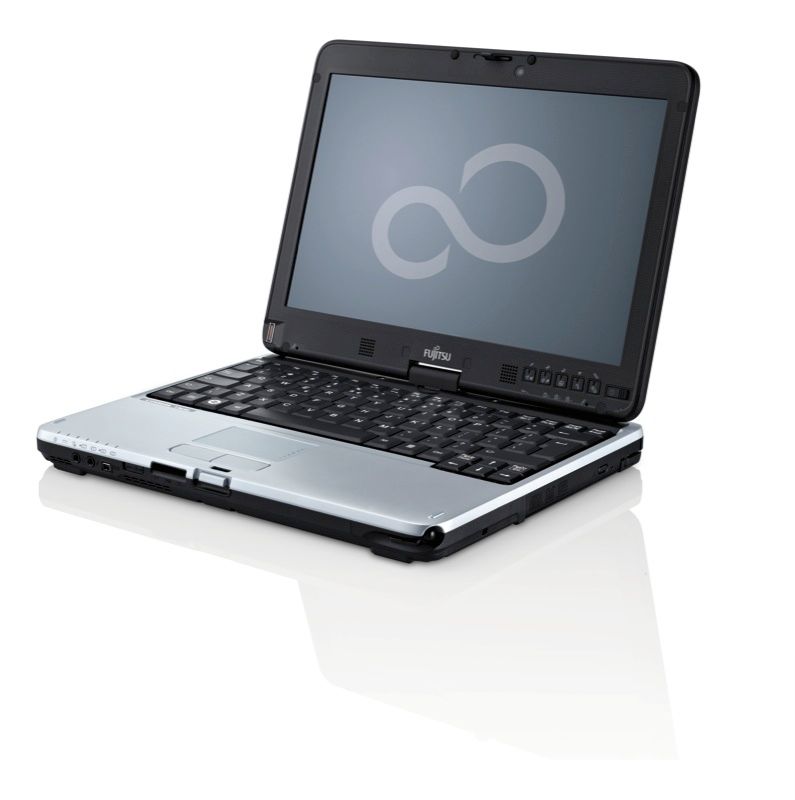The iPad is not the only tablet. Of course, Microsoft had invested in a touchscreen laptop interface way before Apple did, it just never took off. Maybe now the iPad is rolling out, interest in Windows touchscreens will flourish. Mind you, at £999, this computer's more than even the priciest Apple iPad configuration.
Our quick take
This is a hefty laptop which works well as a conventional notebook, but there are lighter, sexier models around. It's the addition of the touchscreen, and a multi-touch one at that, which is the real success of the Lifebook.

Fujitsu Lifebook T4410 notebook - 3.0 / 5
| FOR | AGAINST |
|---|---|
|
|
Before the iPad launch, all Windows Tablet PCs came with keyboards - sometimes detachable - which added to versatility, and to the weight. The keyboard here is firmly attached, though you can spin the display round and fold it back to interact via the screen.
Like the iPhone, the touchscreen on the Lifebook T4410 supports multi-touch, so that familiar pinch-to-zoom manoeuvre can be used here, and it works pretty smoothly, too. Obviously this only works using two fingers rather than a finger and the stylus. The stylus is a good size and thickness, easily gripped and with a suitably placed button to effect a right-click.
The inclusion of Windows 7 Touch Pack makes the most of the touchscreen capabilities with games to familiarise users new to touch. These include a surprisingly addictive garden pond game where you splash paper boats to collect flowers, but avoid candles and a physics-based blackboard game.
As this is a business computer, it comes with a matte rather than a glossy screen (12-inch, 1280 x 800 pixel resolution) with consequently muted colours that wouldn't suit DVD playback. Anyway, a resistive touchscreen never makes graphics look quite their best.
The laptop is built into a serviceable rather than a glam case. Actually, it's pretty dull-looking and quite a weight at 1.79kg. It's certainly solid and sturdy, lumpy rather than svelte, with unexciting colouring: dark grey with a light grey surround on the keyboard, with matching trackpad and mouse buttons. At least it has curvy corners.
There's no graphics card, opting for an onboard solution instead - this laptop is here to help you work, remember. Mind you, it has an HDMI socket so you could output content on a separate screen. At least there's a decent processor (2.53GHz Intel Core 2 Duo P8700) and reasonable memory with 2GB of RAM. The hard drive is surprisingly small at just 160GB and a DVD rewriter rounds out the hardware package.
There are buttons on the screen (they are here instead of on the keyboard because you may have the screen folded over) for extra functions like scrolling documents or spinning the orientation of the display, plus a fingerprint reader for extra security. The keyboard is big and comfortable to use: black keys with large, bright white letters set at the top left of each key. It's one of the most usable keyboards we've come across, beaten by the excellent MacBook Pro's, but not by much else.
Oddly, the trackpad is rather puny - not unusable but a comparative disappointment. Still, this is a touchscreen, so you can interact by touching the display, too. You can use your finger or the stylus which slides out of the base of the laptop. Both work well, and the handwriting recognition Windows 7 includes on tablet PCs is decent enough, managing to decipher our frantic scribbles with acceptable though not perfect results. Good enough for taking notes which you can tidy up afterwards and, frankly, the PC was regularly better at working out what we'd written than we were at reading back our own writing.
Battery life was okay, but not exceptional, easily managing 5 hours with moderate use, but not much more.
To recap
Strong touchscreen chops make up for otherwise average capabilities in a chunky, sometimes clunky, machine
